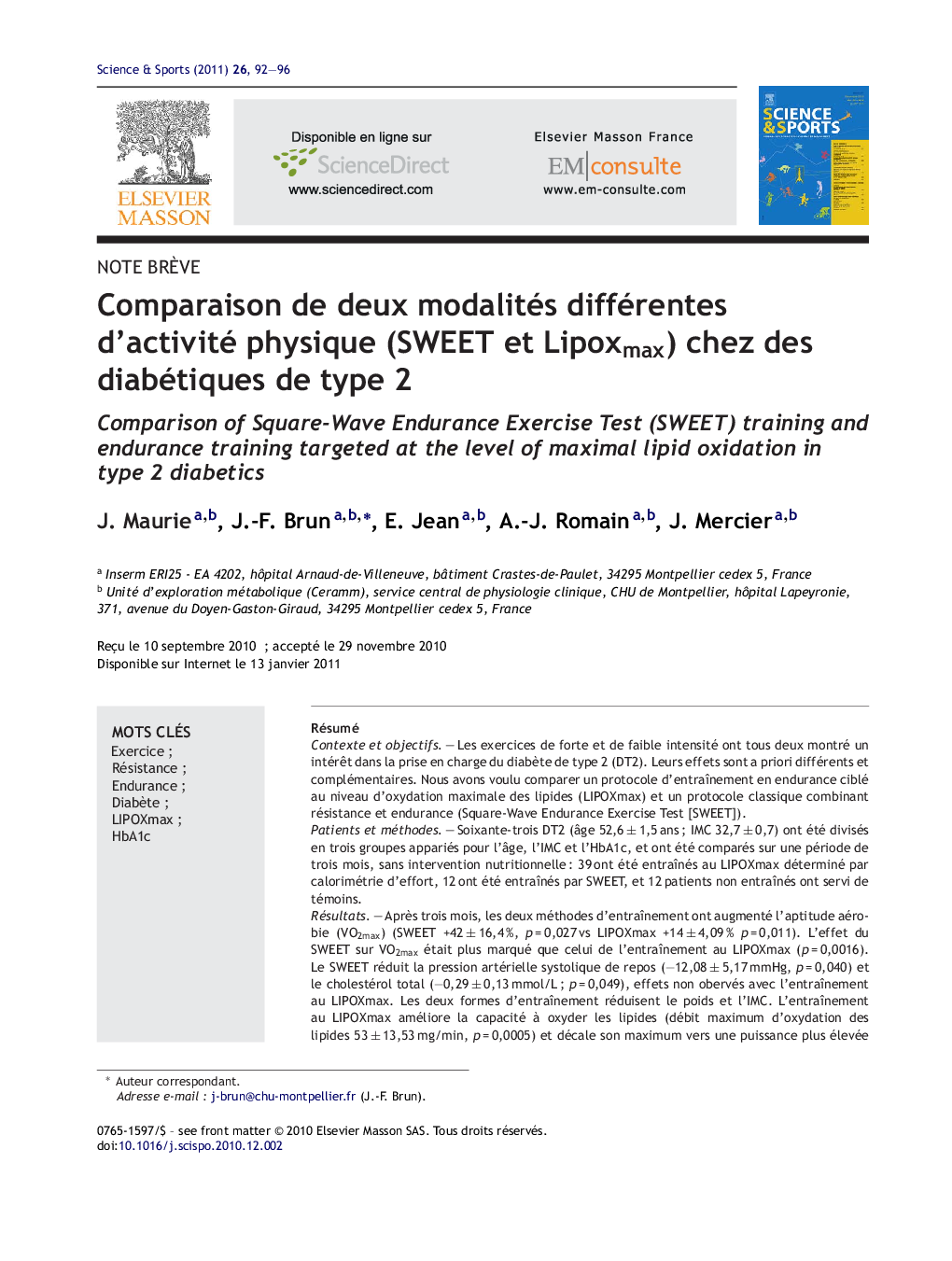| کد مقاله | کد نشریه | سال انتشار | مقاله انگلیسی | نسخه تمام متن |
|---|---|---|---|---|
| 4093521 | 1268313 | 2011 | 5 صفحه PDF | دانلود رایگان |

RésuméContexte et objectifsLes exercices de forte et de faible intensité ont tous deux montré un intérêt dans la prise en charge du diabète de type 2 (DT2). Leurs effets sont a priori différents et complémentaires. Nous avons voulu comparer un protocole d’entraînement en endurance ciblé au niveau d’oxydation maximale des lipides (LIPOXmax) et un protocole classique combinant résistance et endurance (Square-Wave Endurance Exercise Test [SWEET]).Patients et méthodesSoixante-trois DT2 (âge 52,6 ± 1,5 ans ; IMC 32,7 ± 0,7) ont été divisés en trois groupes appariés pour l’âge, l’IMC et l’HbA1c, et ont été comparés sur une période de trois mois, sans intervention nutritionnelle : 39 ont été entraînés au LIPOXmax déterminé par calorimétrie d’effort, 12 ont été entraînés par SWEET, et 12 patients non entraînés ont servi de témoins.RésultatsAprès trois mois, les deux méthodes d’entraînement ont augmenté l’aptitude aérobie (VO2max) (SWEET +42 ± 16,4 %, p = 0,027 vs LIPOXmax +14 ± 4,09 % p = 0,011). L’effet du SWEET sur VO2max était plus marqué que celui de l’entraînement au LIPOXmax (p = 0,0016). Le SWEET réduit la pression artérielle systolique de repos (–12,08 ± 5,17 mmHg, p = 0,040) et le cholestérol total (–0,29 ± 0,13 mmol/L ; p = 0,049), effets non obervés avec l’entraînement au LIPOXmax. Les deux formes d’entraînement réduisent le poids et l’IMC. L’entraînement au LIPOXmax améliore la capacité à oxyder les lipides (débit maximum d’oxydation des lipides 53 ± 13,53 mg/min, p = 0,0005) et décale son maximum vers une puissance plus élevée (+20,9 ± 4,29 watts, p = 0,00002), diminue la masse grasse (–1 ± 0,37 %, p = 0,012), augmente la masse maigre (+1 ± 0,37 % p = 0,012), diminue le tour de taille (–3,76 ± 0,99 cm p = 0,0007) et de hanche (–2,18 ± 0,78 cm p = 0,009) tandis que le SWEET n’affecte pas significativement ces paramètres. Au cours de cette courte période, les effets de l’entraînement sur l’HbA1c ont été significatifs dans le groupe LIPOXmax (–0,15 ± 0,07 % p = 0,044) mais pas dans le groupe SWEET.ConclusionCette étude montre que l’entraînement SWEET améliore l’aptitude aérobie, la pression artérielle et le profil lipidique, alors que l’entraînement en endurance à faible intensité au LIPOXmax améliore la capacité d’oxyder les lipides à l’exercice, augmente la masse maigre, diminue la masse grasse et diminue l’HbA1c. Les avantages de ces deux types d’entraînement sont donc assez différents et tous deux sont sans doute intéressants à combiner dans la prise en charge du DT2.
SummaryBackground and aimsBoth low and high intensity exercise have been demonstrated to be useful in the management of type 2 diabetes. Their effects are likely to be different and complementary. We aimed at comparing in type 2 diabetes a protocol of endurance training precisely targeted at the power intensity of maximal lipid oxidation (LIPOXmax) with a protocol combining resistance and endurance training (Square-Wave Endurance Exercise Test [SWEET] training).Patients and methodsSixty-three type 2 diabetics (age 52.6 ± 1.5 years; BMI 32.7 ± 0.7) were divided into three groups matched for age, BMI, and HbA1c and were compared over a period of 3 months, without nutritional intervention: 39 were trained at the LIPOXmax determined with exercise calorimetry, 12 were submitted to a SWEET training, and 12 untrained patients served as controls.ResultsAfter 3 months, both procedures increased maximal aerobic capacity (VO2max) (SWEET training +42 ± 16.4%, P = 0.027 vs LIPOXmax training +14 ± 4.09%, P = 0.011). The effect of SWEET training on VO2max was stronger than that of LIPOXmax training (P = 0.0016). SWEET training reduced resting systolic blood pressure (–12.08 ± 5.17 mmHg, P = 0.040) and total cholesterol (–0.29 ± 0.13 mmol/L, P = 0.049), while LIPOXmax training did not. Both procedures decreased weight and BMI. By contrast, the LIPOXmax training improved the ability to oxidize lipids (maximum lipid oxidation rate +53 ± 13.53 mg/min, P = 0.0005) shifted it to a higher power intensity (+20.9 ± 4.29 watts, P = 0.00002), decreased fat mass (–1 ± 0.37% ; P = 0.012), increased fat-free mass (+1 ± 0.37%, P = 0.012), decreased waist circumference (–3.76 ± 0.99 cm P = 0.0007) and hip circumference (–2.18 ± 0.78 cm, P = 0.009) while SWEET training did not significantly affect any of those parameters. Over this short period the effects of training on HbA1c were significant in the LIPOXmax group (–0.15 ± 0.07%, P = 0.044) but not in the SWEET group.ConclusionThis study shows that SWEET training improves aerobic working capacity, blood pressure and lipid profile, while low intensity endurance training (LIPOXmax training) improves the ability to oxidize lipids at exercise, increases fat-free mass, decreases fat mass and decreases HbA1c. The benefits of these two procedures are thus quite different and both are probably interesting to associate in the management of type 2 diabetes.
Journal: Science & Sports - Volume 26, Issue 2, April 2011, Pages 92–96